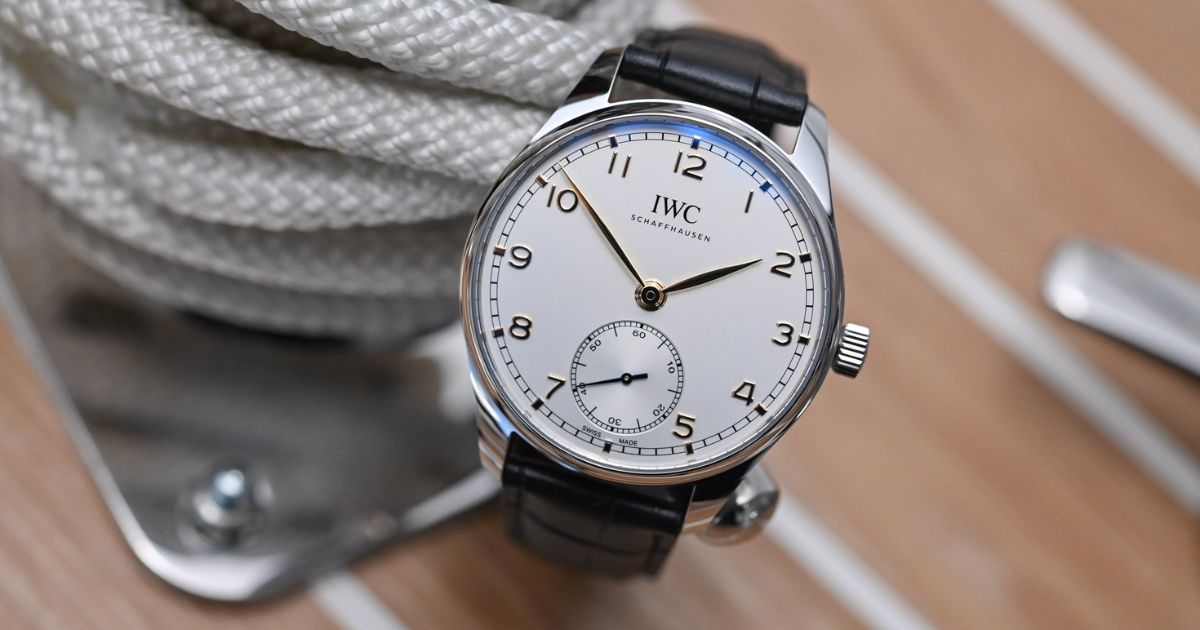Our Magazine
The Unmistakable Dial: What Makes an IWC Portugieser

If you’ve spent any time in the world of horology, you’ve seen it. On a wrist across a restaurant, in the pages of a glossy magazine, or perhaps beckoning from a display case. It’s a watch that doesn’t shout, but instead, speaks in a clear, confident whisper of precision and elegance. It’s the IWC Portugieser, and its identity is defined, first and foremost, by its dial.
The story of the Portugieser is now the stuff of legend. In the late 1930s, two Portuguese businessmen—Rodrigues and Teixeira—approached International Watch Company (IWC) in Schaffhausen with a simple, yet demanding request. They wanted a wristwatch that possessed the precision of a marine chronometer, a instrument-grade timekeeper essential for navigation at sea. This was a radical idea at a time when wristwatches were often smaller and less precise. IWC’s ingenious solution was to house a large, pocket-watch-derived movement—the legendary Calibre 74—into a spacious wristwatch case. The result was the Reference 325, the progenitor of a line that would become an icon.
But what is it about this watch, born from a pragmatic need, that has transcended its origins to become a timeless design? The answer lies in a masterful interplay of elements that create a whole far greater than the sum of its parts.
The Canvas: Legibility as a Design Principle
The Portugieser dial is a study in purpose-driven design. Its primary function, dictated by its seafaring heritage, is legibility. Every element is subservient to this goal.
-
The Arabic Numerals: These are the soul of the Portugieser. They are not merely printed; they are typically applied, polished, and faceted, catching the light with a subtle brilliance. Their font is a specific, elegant serif style—bold, yet refined. They are large and unapologetic, occupying their space with authority, ensuring time can be read at a mere glance.
-
The Track Railway Minute Scale: Encircling the dial is a precise, finely printed or applied track for the minutes. This is a direct nod to scientific and navigational instruments, where precise readings are paramount. The contrast between the bold Arabic hour numerals and this delicate, detailed outer track creates a beautiful visual rhythm.
-
The “Leaf” Hands: The classic Portugieser often features elegant, leaf-shaped hands for the hours and minutes. They are slim, polished to a mirror finish, and perfectly proportioned to glide over the numerals without obscuring them. In certain models, like the chronograph, feuille (leaf) or alpha hands are used, always maintaining an air of classicism.
This triad—bold Arabic numerals, a railway minute track, and elegant hands—creates a dial of unparalleled clarity and balance. It is a design so effective it feels almost inevitable.
The Architecture: Proportion and Presence
The Portugieser’s case is the foundation of its wrist presence. It is almost always a simple, round case, but its execution is key.
-
The Thin Bezels: The bezel is remarkably slim. This is a critical design choice, as it allows the dial to be the undisputed star of the show. By minimizing the bezel, IWC maximizes the dial’s real estate, enhancing its legibility and giving the watch an open, expansive feel.
-
The Case Size: True to its origins, the Portugieser has always been a larger watch. Even by today’s standards, models typically range from 40mm to 44mm. However, due to the elegant lug design and the thin profile (especially in time-only and automatic models), it wears with a sophisticated presence rather than a bulky one. The lugs are often elegantly curved, ensuring the watch sits comfortably on the wrist.
The Complication: The Heartbeat of the Portugieser
While the time-only model is a pure expression of the original concept, the Portugieser truly came into its own with the introduction of the chronograph. The Ref. 3714, with its two sub-dials positioned at 12 and 6 o’clock, became a modern icon. This layout is a masterstroke of symmetry. It doesn’t clutter the dial; it completes it. The sub-dials, often snailed or textured for contrast, balance the visual weight of the dial perfectly, creating a harmonious and instantly recognizable face.
Beyond the chronograph, the Portugieser family showcases IWC’s technical prowess with breathtaking complications. The Perpetual Calendar, with its clean, four-sub-dial display, is a miracle of mechanical programming disguised as an exercise in typography. The Tourbillon mystique adds a dynamic, rotating spectacle at 6 o’clock. And then there the Grande Complication, a pinnacle of haute horlogerie. Yet, no matter how complex the movement, the dial almost always retains the core DNA of legibility and balance.
The Evolution: Honoring a Code
A common pitfall for iconic watches is stagnation or, conversely, losing their identity through over-styling. The Portugieser has navigated this with remarkable grace. Over the decades, IWC has introduced new models, materials, and colors—from deep blue and burgundy to elegant slate grey and classic white.
Yet, the “Portugieser Code” remains inviolable. The Arabic numerals, the railway track, the slim bezel, and the overall pursuit of balance are non-negotiable. A modern Portugieser with a blue dial and rose gold case is unmistakably related to the Ref. 325 from 1939. This consistency is not a lack of imagination; it is a profound respect for a design that has proven to be perfect.
Conclusion: More Than a Watch, a Statement
The IWC Portugieser is not defined by any single feature, but by a philosophical commitment to clarity, elegance, and technical integrity. It is a watch born from the sea, refined for the boardroom, and cherished by those who appreciate a tool that has been elevated to an art form. Its dial is its signature—a clean, uncluttered, and deeply intelligent face that tells you more than just the time. It tells a story of a specific request, a brilliant solution, and a timeless design that continues to speak, unmistakably, of pure horological class.













